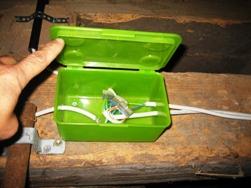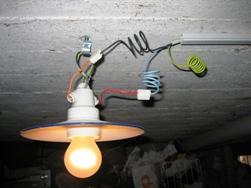Categories: Featured Articles » Electrician at home
Number of views: 62304
Comments on the article: 2
Wiring in the attics and basements
Basement and attic wiring
Long gone are the days when basements and attics were left empty or, at best, used them as technical rooms, where various communications were installed - sewage, ventilation, heating.
But all the same, there are situations when it is necessary to install wiring in the attics, in basements, cellars. In this article, we will try to figure out how to correctly produce electrical wiring.
So, before you begin installation, you need to determine what type of premises the basement and attic belong to. Let's start with the basement. Basements relate to premises with high humidity, therefore, increased requirements are imposed on the wiring in this case.
So, the voltage in rooms with high humidity should be no more than 48 V, the wires should correspond to the load, taking into account the low voltage.
 Using step-down transformer, wire laying height is not regulated. But very often it happens that, due to the specifics of the room or equipment used in this room, the voltage should be more than 48 V, then in this case the height of the wires should be at least 2500 mm.
Using step-down transformer, wire laying height is not regulated. But very often it happens that, due to the specifics of the room or equipment used in this room, the voltage should be more than 48 V, then in this case the height of the wires should be at least 2500 mm.
Wiring is best execute in a hidden way, under a layer of plaster, the thickness of the plaster layer on top of the wires should be at least 10 mm. It is also allowed to perform electrical wiring in an external way: on rollers, protected by wires, designed for external installation; in metal pipes whose wall thickness is at least 2 mm.
 When installing electrical wiring in metal pipes, it is necessary to ensure that the slope of the pipes is sufficient so that water does not accumulate in the pipes. All metal parts must be earthed or nullified to prevent electric shock in the event of an insulation breakdown. All wire connections should be made in hermetically sealed junction boxes to prevent moisture from getting inside.
When installing electrical wiring in metal pipes, it is necessary to ensure that the slope of the pipes is sufficient so that water does not accumulate in the pipes. All metal parts must be earthed or nullified to prevent electric shock in the event of an insulation breakdown. All wire connections should be made in hermetically sealed junction boxes to prevent moisture from getting inside.
Luminaires designed for installation in basements must be airtight, eliminating the ingress of moisture inside. Circuit breakers socketsStep-down transformers should be located outside the basements.
Further, to what type of premises can be attributed attic non-residential premises. The attic type is subject to increased fire safety requirements, since in attics, as a rule, a large amount of dust is collected, which, if the wiring rules are not followed, can easily provoke a fire.
 In addition, most attic structures are wooden, and wood, even if soaked with fire-fighting compounds, is still easily exposed to fire. What you need to know in order for the wiring in the attic to meet the requirements?
In addition, most attic structures are wooden, and wood, even if soaked with fire-fighting compounds, is still easily exposed to fire. What you need to know in order for the wiring in the attic to meet the requirements?
So, wires can be laid in two main ways. In both cases, the wiring is performed in an open way. The first way is on casters. The height of the wires from the floor should be at least 2.5 meters. The distance between the rollers is not more than a meter, the distance between the wires is at least 5 cm, the height of the rollers is at least 3 cm.
The second way is electrical wiring in metal pipes or in plastic pipes that do not support combustion. In the case of the use of metal pipes, they (pipes) must be grounded or nullify.
As in the case of installation of electrical wiring in the basement, the fixtures must be sealed to prevent dust from entering.Switches, sockets and other equipment must also be placed outside the attic.
Sergey Seromashenko
Recommended reading: How to safely make lighting in the basement of a garage and apartment building
See also at bgv.electricianexp.com
:

